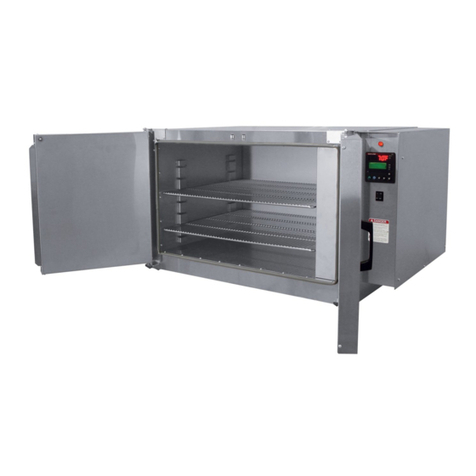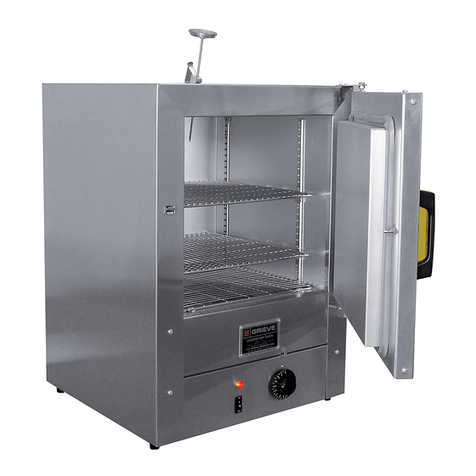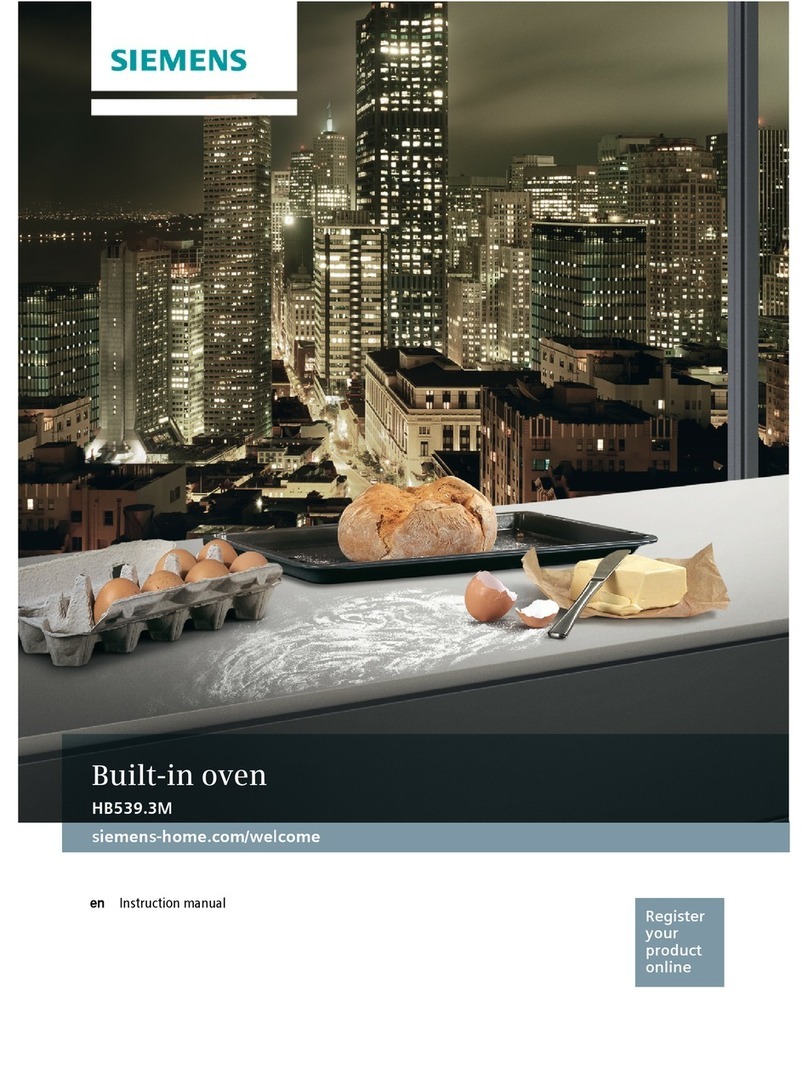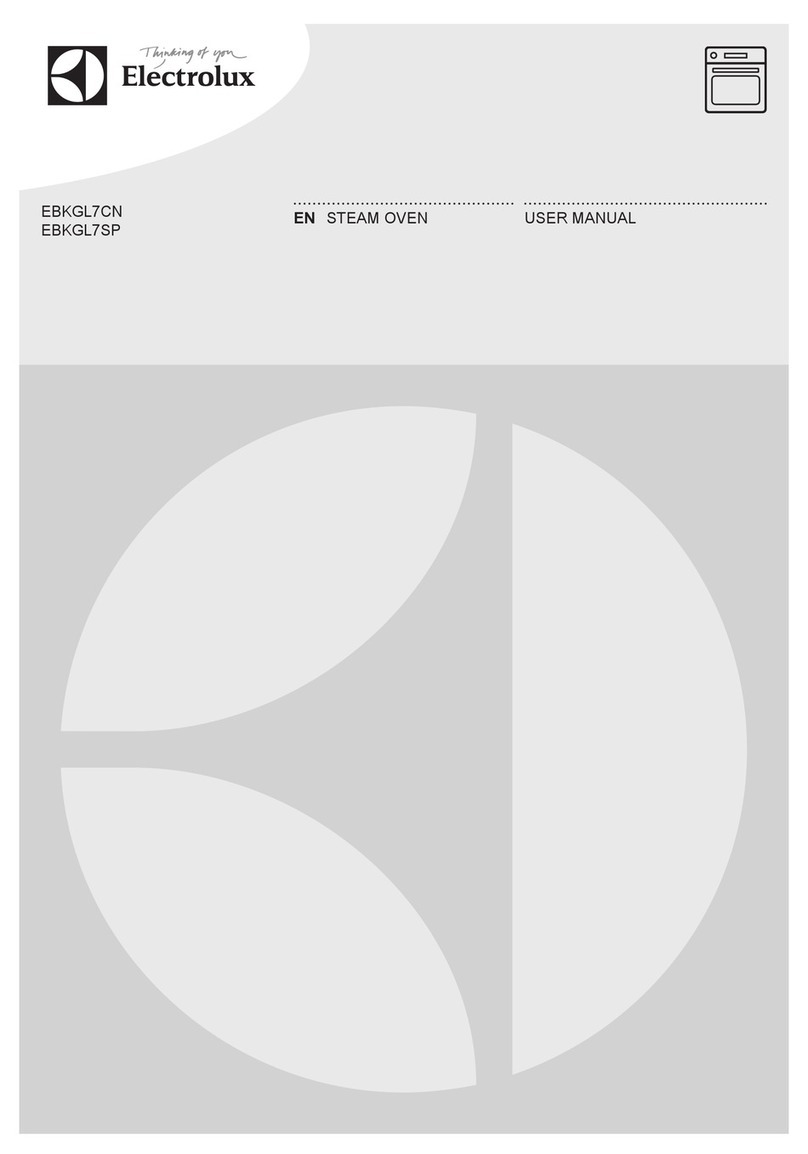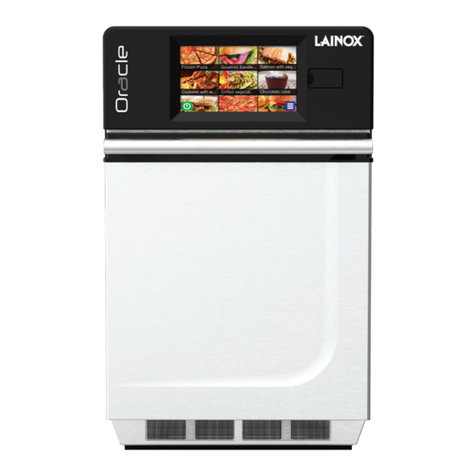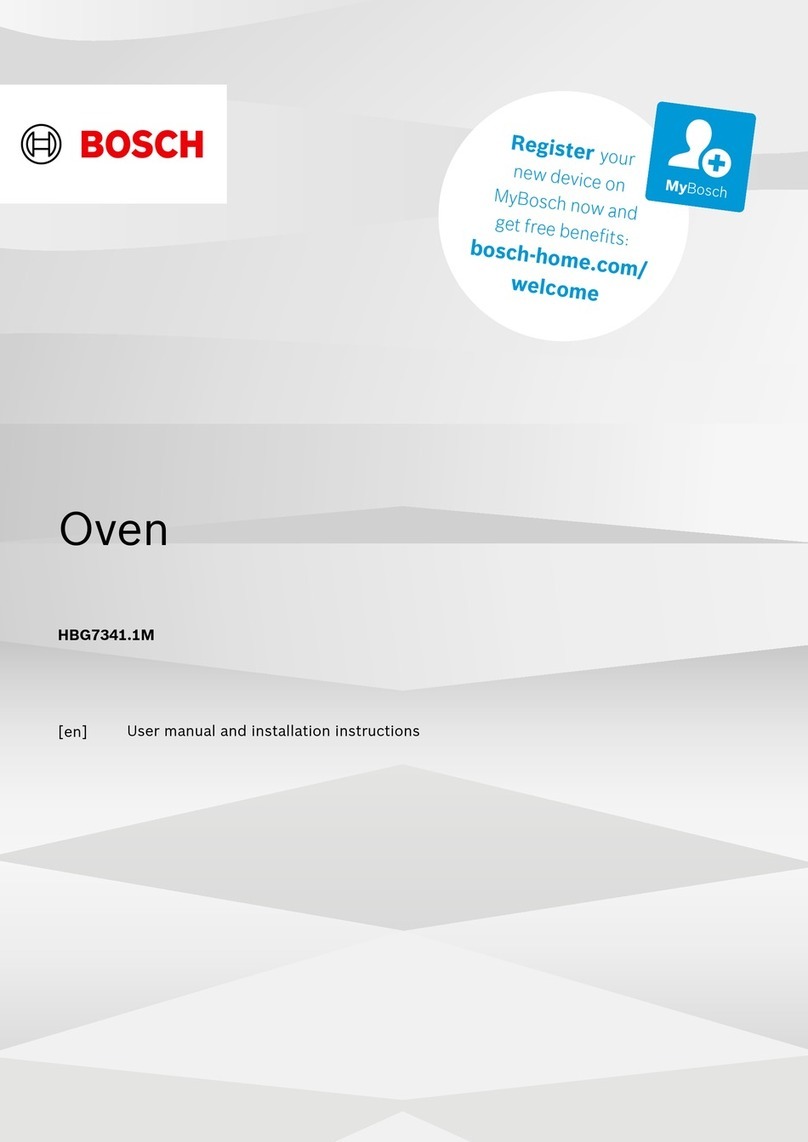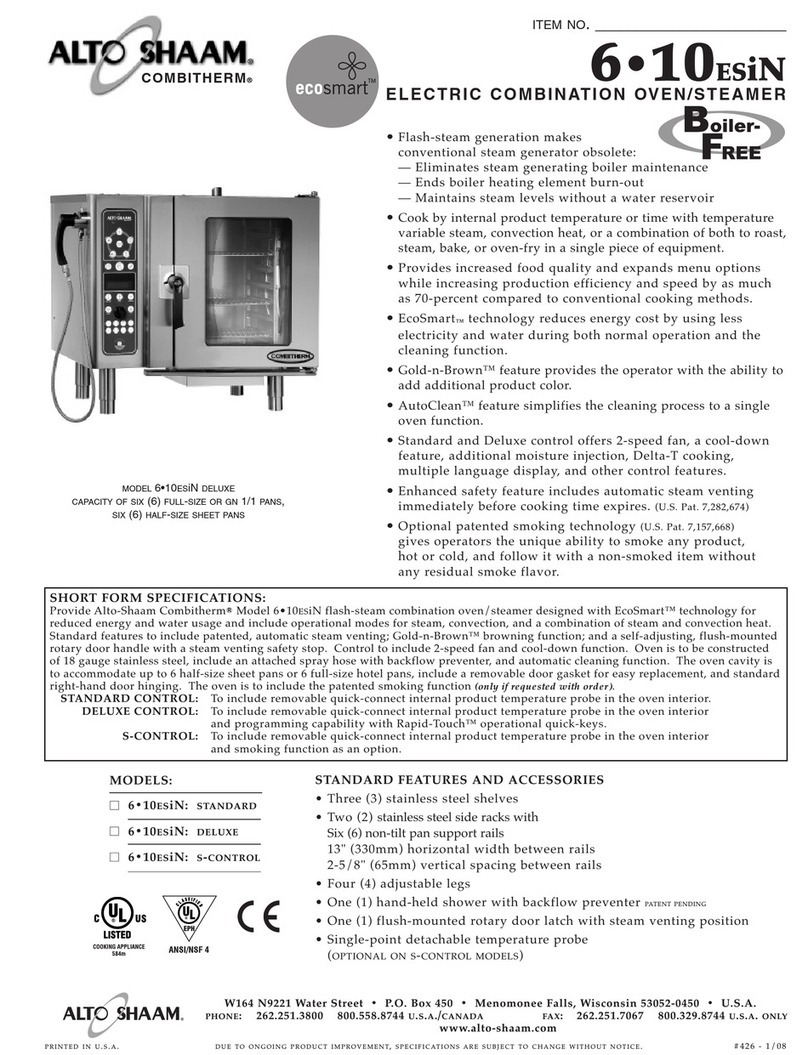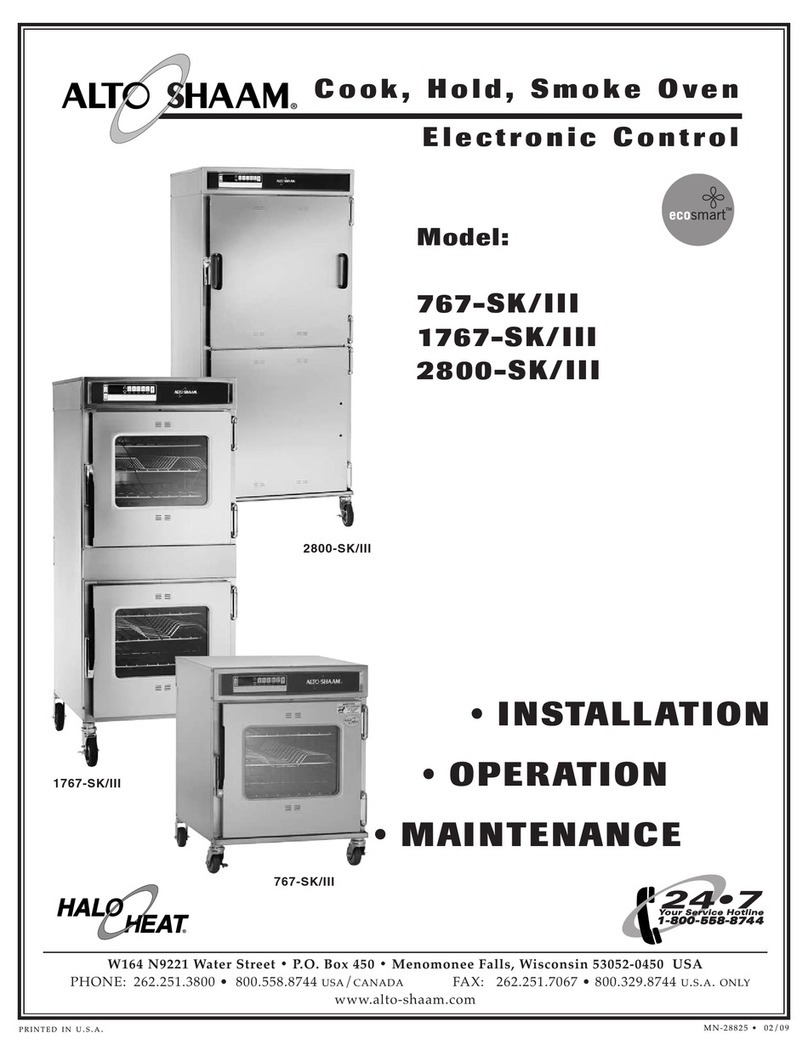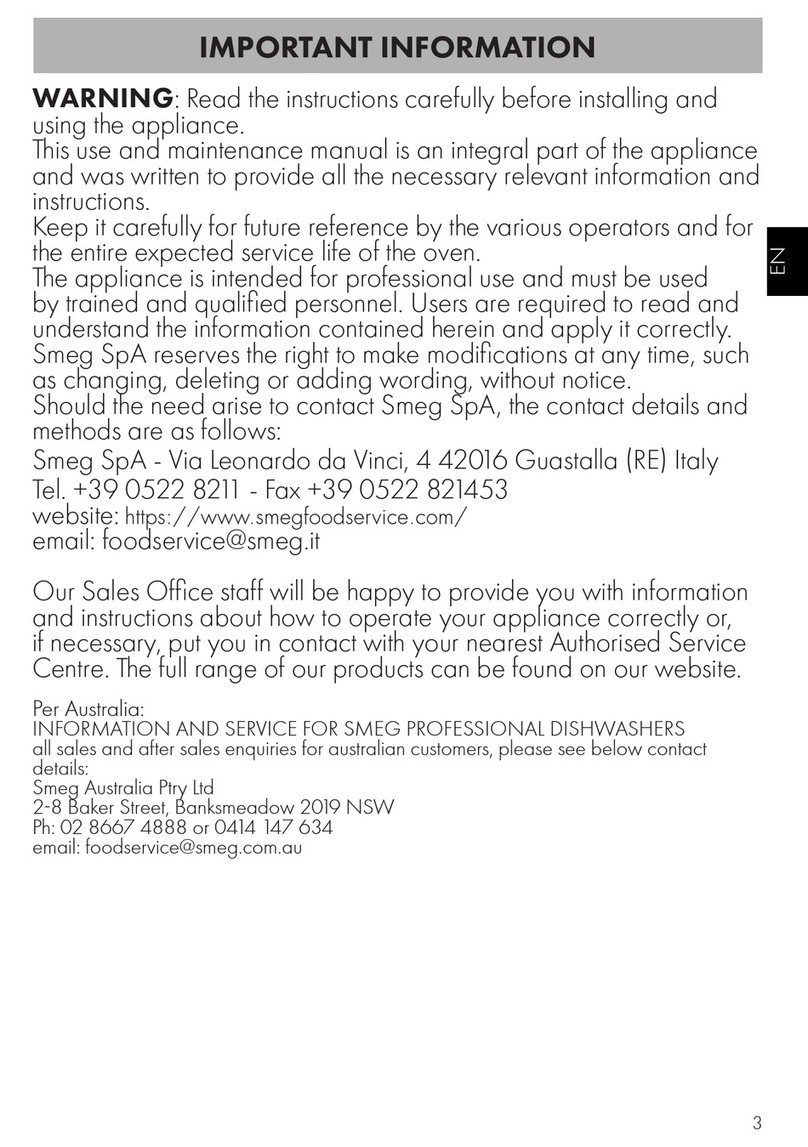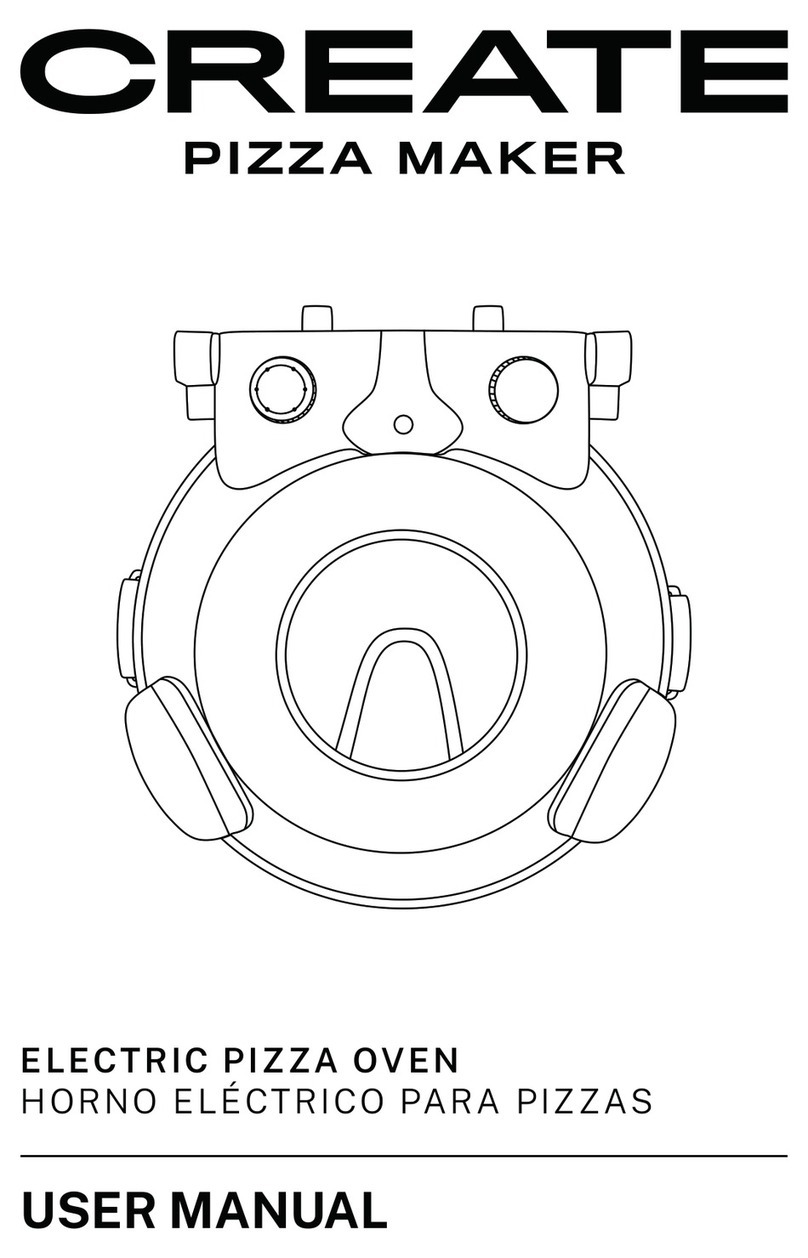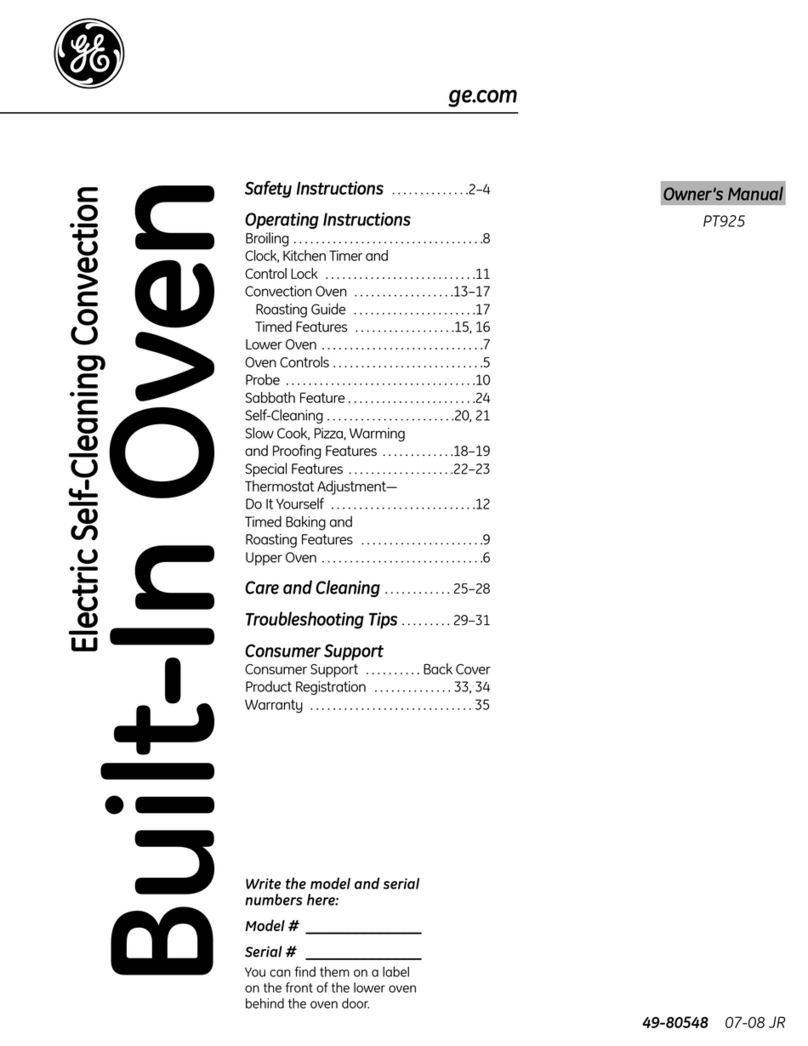Grieve AA-550 Manual

1 of 38 10/2018
W:\Electrical\MANUAL\OVEN OPERATING INSTRUCTIONS\GENERAL INSTRUCTIONS\Oven General Instructions
Rev. B.doc
GENERAL INSTALLATION, OPERATION AND MAINTENANCE INSTRUCTIONS
FOR OVENS
TABLE OF CONTENTS
1 SHIPPING DAMAGE & HANDLING
2 PROPER OVEN APPLICATION
2-1 General
2-2 Flammable Solvents
2-3 Combustible Material
2-4 Personnel Hazards
2-5 Maintenance and Inspection
3 INSTALLATION
3-1 Location
3-2 Building Considerations
3-3 Clearances
3-4 Ventilation
3-5 Exhaust Ductworks
3-6 Fuel Gas Supply
3-7 Electrical
4 PRIOR TO PLACING OVEN IN SERVICE
5 PROCESSING
6 SAFETY EQUIPMENT
7 MAINTENANCE
8 TROUBLE SHOOTING
9 APPENDIX A - SAFETY EQUIPMENT, DESCRIPTION & OPERATION
10 APPENDIX B - REFERENCES
11 APPENDIX C - MINIMUM PERIODIC MAINTENANCE REPORT
12 APPENDIX D - SAFETY SHUT OFF VALVE LEAK TEST PROCEDURE
13 APPENDIX E - WARRANTY AND LIMITATIONS OF REMEDIES
Following these GENERAL INSTRUCTIONS in your manual are the following:
-OPERATING INSTRUCTIONS SPECIFIC FOR YOUR EQUIPMENT
-MECHANICAL PARTS LIST
-ELECTRICAL WIRING AND COMPONENT PARTS LIST
-LITERATURE AND INSTRUCTIONS ON COMPONENTS
These GENERAL INSTRUCTIONS have been written for many different types of ovens,
therefore, some equipment or components referred to may not be present on your particular
piece of equipment.
After reading these GENERAL INSTRUCTIONS, also read the specific OPERATING
INSTRUCTIONS written for your equipment. An additional copy of the OPERATING
INSTRUCTIONS is provided in a plastic cover. Post these instructions at the oven for the
operator to reference.

2 of 38 10/2018
W:\Electrical\MANUAL\OVEN OPERATING INSTRUCTIONS\GENERAL INSTRUCTIONS\Oven General Instructions
Rev. B.doc
1SHIPPING DAMAGE AND HANDLING
DO NOT RETURN DAMAGED MERCHANDISE TO US.
FILE YOUR CLAIM AS OUTLINED BELOW.
This merchandise has been thoroughly inspected and carefully packed before leaving our
plant. The carrier assumed responsibility for its safe delivery at the time of shipment.
Claims for loss or damage to the contents must be made with the carrier, as follows:
1-1 VISIBLE LOSS OR DAMAGE
Any external evidence of loss or damage must be noted, at the time of delivery, on the
freight bill or express receipt and signed by the carrier's agent. Failure to adequately
describe such external evidence of loss or damage may result in the carrier refusing to
honor a damage claim. Make a written request for inspection by the carrier's agent
within fifteen days of the delivery date. Review the inspection report and do not sign it
unless it adequately describes the damage.
A claim must be filed with the carrier since such damage is the carrier's responsibility.
1-2 CONCEALED LOSS OR DAMAGE
Concealed loss or damage means loss or damage, which does not become apparent
until the merchandise has been unpacked. The contents may be damaged in transit
due to rough handling even though the carton may not show external damage. When
the damage is discovered upon unpacking, contact the carrier and make a written
request for inspection by the carrier's agent within fifteen days of the delivery date.
Review the inspection report and do not sign it unless it adequately describes the
damage.
A claim must be filed with the carrier since such damage is the carrier's responsibility.
By following these instructions carefully, we guarantee our full support of your claims to
protect you against loss from concealed damage.
1-3 RETURNING DAMAGED EQUIPMENT
Damaged equipment will not be accepted at our factory unless we have been advised
and instructions provided on how it should be returned. A copy of the freight claim must
be provided prior to returning the equipment.
1-4 HANDLING
After inspection, store and handle all equipment and components in their original crates
until ready for installation. Handle with care. The equipment may be heavy but some
components are of a delicate nature. If the equipment is to be stored, keep it in the
original crates and store in a location free from excessive dust, heat and moisture until
ready for installation.

3 of 38 10/2018
W:\Electrical\MANUAL\OVEN OPERATING INSTRUCTIONS\GENERAL INSTRUCTIONS\Oven General Instructions
Rev. B.doc
2PROPER OVEN APPLICATION
2-1 GENERAL
2-1.1 While ovens are extremely versatile, they are usually purchased with a specific
application in mind. If your process has changed significantly or if you should
have reason to doubt that a specific application is a proper use of the equipment,
consult the factory before proceeding.
2-1.2 Explanatory Material (Annex A1.1) of National Fire Protection Association
Publication 86 "Standard for Ovens and Furnaces" states; in part:
"Explosions and fires in fuel-fired and electric heat utilization equipment
constitute a loss potential in life, property and production.”
“Most failures can be traced to human error. The most significant failures
include inadequate training of operators, lack of proper maintenance, and
improper application
of equipment.
2-1.3 To protect the oven, oven contents, property and personnel, a responsible
person should be in attendance during operation. Do not operate oven
unattended. Special attention must be paid to:
-Setting correct temperature.
-Placing flammable solvents in an oven not designed for that purpose.
-Placing combustibles in an oven that does not have adequate fire
protection.
-Allowing the product to remain in the oven too long, thereby
encouraging combustion.
-Using an oven for a process other than that for which it was designed.
2-1.4 Oven operator should shut down the oven immediately and notify their
supervisor if there are changes in oven performance, a safety interlock trips
or, in the case of fuel fired equipment, the smell of natural gas or propane is
present. The oven should not be put back into production until the causes
are found and corrected.
2.2 FLAMMABLE SOLVENTS
2-2.1 Processing solvents in a non-solvent oven, exceeding the design temperature, or
exceeding the maximum amount of solvent allowed in an oven, could result in
fire or explosion and bodily injury or property loss.
If flammable solvents or vapors will be present in an oven, the Occupational
Safety & Health Administration (OSHA) requires that it have a separately
powered forced exhauster of adequate size and other related safety devices not
supplied as standard equipment. Ovens designed for this purpose have a
caution plate and Safety Design Form showing the maximum gallons of solvent,
or pounds of powder coating, and the maximum operating temperature for which
that specific oven has been designed. If in doubt, consult factory for details.
2-2.2 It shall be the user's responsibility to ensure that the amount of flammable
solvent placed in the oven and the operating temperature does not exceed the
design capacity -- see Safety Design Form and oven caution nameplate.

4 of 38 10/2018
W:\Electrical\MANUAL\OVEN OPERATING INSTRUCTIONS\GENERAL INSTRUCTIONS\Oven General Instructions
Rev. B.doc
2-2.3 In areas outside of the oven where flammable solvents are given off by material
prior to entering the oven, provisions shall be made to exhaust these vapors to
atmosphere to prevent them from being pulled into the oven or collecting and
creating a flammable mixture.
2-3 COMBUSTIBLE MATERIAL
2-3.1 Introduction of combustible materials (such as paper, cardboard or wood) into
the oven should be avoided because it might cause a fire. Do not use
combustible racks, trays, holders, spacers, etc. Periodically, clean all
combustible material from non-combustible racks, trays, holders, spacers, etc. If
combustible products must be processed in an oven, extreme care must be
taken to ensure that the operating temperature does not exceed the ignition
temperature of the product.
2-3.2 Ovens containing or processing sufficient combustible materials (including
consideration for combustible drippings or deposits) to sustain a fire shall be
equipped with an automatic fire protection system including areas in exhaust
ducts that could accumulate combustible material. Fire protection systems
should be installed in accordance with the applicable National Fire Protection
Guidelines:
-sprinkler systems in accordance with NFPA 13
-water spray systems in accordance with NFPA 15
-carbon dioxide extinguishing systems in accordance with NFPA 12
-foam extinguishing systems in accordance with NFPA 11
-dry chemical extinguishing systems in accordance with NFPA 17
-water mist systems in accordance with NFPA 750
The extent of protection required will depend upon the construction and
arrangements of the oven as well as the materials handled. Fixed protection,
such as automatic sprinklers or other types of fire extinguishing systems should
be designed and installed by a qualified contractor.
2-3.2.1Activation of fire protection system shall comply with NFPA 86 11.5 providing
-safety shut down of oven
-discontinue introduction of flammable or combustible material
-position dampers to maintain minimum air flow through oven to prevent
combustible concentration from exceeding 25% of lower flammable limit
(LFL)
-keep fans in operation to maintain required safety ventilation to prevent
combustible concentration from exceeding 25% of lower explosive limit
(LFL)
-shut down recirculation and exhaust fans and close dampers where
type of fire protection requires that ventilation be discontinued.
2-3.3 Drip pans shall be provided to collect any combustible materials that may
accumulate beneath the product. A maintenance program must be developed to
remove any such accumulation before a substantial build up occurs that could
spontaneously ignite and cause a fire. If you cannot acquire drip pans locally,
contact us for a quotation.

5 of 38 10/2018
W:\Electrical\MANUAL\OVEN OPERATING INSTRUCTIONS\GENERAL INSTRUCTIONS\Oven General Instructions
Rev. B.doc
2-4 PERSONNEL HAZARDS
2-4.1 You must analyze your use of this equipment and determine if it creates a
confined space hazard, as defined by OSHA, in your work place. You are
responsible for posting appropriate warnings and complying with applicable
OSHA STANDARDS pertaining to confined space hazards. Reference ANSI
Z117-1 “Safety Requirements for Confined Spaces”; see Appendix B.
2-4.2 If inert atmospheres are to be used, keep in mind that inert gases displace air
and create oxygen-deficient atmospheres. For this reason, they can cause
suffocation. Moreover, some inert gases, such as argon, are heavier than air
and can collect in low lying or sealed areas creating oxygen-deficient pockets
within the work place. Use inert atmospheres only in large work places with
good ventilation. Do not breathe in or enter an inert atmosphere piece of
equipment until it has been thoroughly purged with air.
2-4-3 Explosion venting door latches will allow oven doors to open if pressure
develops in the oven. For this reason doors should face away from main aisles
and work areas.
2-4.4 Heat processing equipment must always be used with caution. Proper
equipment such as insulated gloves, safety goggles and tongs should be used
for reaching into hot equipment. Proper supervision is essential and only trained
personnel should be allowed to operate the oven.
Always remember you are working with elevated temperatures.
-Do not touch surfaces - they could be hot and burns could result.
-Do not breathe hot oven air. Heated air could burn lungs.
-Many items become dangerous when heat is applied. Explosion or fire
could result. Make sure you know what you are putting in the oven can
be heated safely at the oven operating temperature.
2-4.5 Disconnect power before servicing equipment. Ovens operate under high
voltage and electrical shock is possible. Proper panel lockout procedures should
be followed.
2-4.6 Disconnect other sources of potential energy such as compressed air, before
servicing. Proper lockout procedures should be followed.
2-4.7 Do not operate mechanical or electrical equipment with guards removed.
Operating with guards removed could result in bodily injury.
2-4.8 Ovens with vertical lift doors or top-loading doors must be blocked open before
passing beneath them. A falling door may cause bodily injury. A safety pin or
support strut is provided for this purpose.
2-5 MAINTENANCE AND INSPECTION
2-5.1 Regularly scheduled inspection and maintenance of all safety devices shall be
performed by user. Failure to do this may result not only in fire or explosion
damage, but also contribute to accidental shutdowns and loss of production.
See Section 7 “Maintenance” and Appendix C “Minimum Periodic Maintenance
Report”.

6 of 38 10/2018
W:\Electrical\MANUAL\OVEN OPERATING INSTRUCTIONS\GENERAL INSTRUCTIONS\Oven General Instructions
Rev. B.doc
2-5.2 Regularly scheduled inspection of the oven interior, heat chamber and ductwork
shall be performed by user to determine need for cleaning and repair. Failure to
do this may result in internal fires or component failure resulting in oven damage
and loss of production.
2-5.3 It shall be the sole responsibility of the user to establish, schedule and enforce the
frequency of and the extent of the inspection/maintenance program (as well as
the corrective action to be taken) because only the user can know what the
actual operating conditions are. Contact your insurance authority, Factory
Mutual or the National Fire Protection Association, whose addresses are listed in
Appendix B, for more information on inspection/maintenance programs.
2-5.4 It shall be the responsibility of the end user to determine that current processing is
within the scope of the original design of the equipment.
2-6 RETROACTIVITY
This equipment has been designed and manufactured in accordance with applicable
National Codes in effect as of the date of manufacture. It is the responsibility of the end
user to update equipment as necessary to comply with future code changes. If you are
in doubt, contact manufacturer to review your equipment design against current National
Codes.

7 of 38 10/2018
W:\Electrical\MANUAL\OVEN OPERATING INSTRUCTIONS\GENERAL INSTRUCTIONS\Oven General Instructions
Rev. B.doc
3 INSTALLATION
3-1 LOCATION
3-1.1 Ovens shall be located to protect them from damage by external heat, vibration
and mechanical hazards.
3-1.2 Ovens shall be located to make maximum use of natural ventilation, to minimize
restrictions to adequate explosion relief, and to provide sufficient air supply for
personnel. Room volume should be at least 10 times the oven volume.
3-1.3 Ovens shall be located to minimize exposure to power equipment, process
equipment and sprinkler risers. Unrelated stock and combustible materials shall
be maintained at a fire-safe distance but not less than 10 feet from an oven, an
oven heater or ductwork.
3-1.4 Ovens shall be located to minimize exposure to people from the possibility of
injury from fire, explosion, asphyxiation, and hazardous materials and shall not
obstruct personnel travel to exit ways.
3-1.5 If the oven control panel is located away from the oven, operators must be
allowed access to the control panel and/or main disconnect to allow them to shut
down the oven in an emergency.
3-1.6 Ovens shall be located to prevent an ignition source to flammable coating dip
tanks, spray booths and storage and mixing rooms for flammable liquids, and to
prevent exposure to flammable vapor or combustible dust clouds. Ovens should
not be located in hazardous (classified) locations unless they are designed to
comply with the applicable requirements of NFPA 70 “National Electrical Code”
(see Appendix B).
3-1.7 Equipment shall be protected from corrosive external processes and
environments, including fumes or materials from adjacent processes or
equipment that produces corrosive conditions when introduced into the oven
environment.
3-1.8 The oven is not intended for outdoor installation and must be sheltered from
weather. Unheated shelters may result in non-uniform temperatures or
insufficient heat to attain maximum operating temperature. Condensation may
also occur which would be detrimental to the steel structure and electrical
components.
3-1.9 Suitable portable fire extinguishers should be available and operators trained in
their use. All such fire protection equipment should be inspected periodically in
accordance with appropriate standards. Reference NFPA 10 “Standard for
Portable Fire Extinguishers” (see Appendix B).
3-2 BUILDING CONSIDERATIONS
3-2.1 When selecting the location for an oven, consideration must be given to the
possibility of fire, building damage and personal injury. Hazards to be
considered include overheating of material in the oven and escape of fuel gas or
exhaust into the work place.
3-2.2 Ovens shall be located and erected so that the maximum anticipated
temperature does not affect the building structural members adversely or by the
additional loading caused by the oven and load.

8 of 38 10/2018
W:\Electrical\MANUAL\OVEN OPERATING INSTRUCTIONS\GENERAL INSTRUCTIONS\Oven General Instructions
Rev. B.doc
3-2.3 Ovens should be placed on noncombustible floors or on structures approved for
use over combustible floors such as concrete floor slabs or hollow tiles.
3-2.4 If necessary, level the oven using shims. Due to expansion, larger ovens may
change shape when heated and require the shims to be adjusted when the oven
is hot. Where mounting holes are provided, anchor the oven securely. Shims
should be permanently mounted to the oven after installation.
3-3 CLEARANCES
3-3.1 Ovens shall be located with adequate space above and on all sides to allow for
inspection, maintenance and operator access. Provisions also shall be included
for unobstructed discharge of building sprinklers, the installation of automatic fire
protection system within the oven, if necessary, and the proper functioning of
explosion relief doors and panels.
3-3.2 Do not place the oven up against a wall. A minimum air space of 3 inches must
be provided on all sides to allow for air circulation, with additional space being
provided for ovens operating over 450F (232C) to keep temperature at
adjacent structures and materials below 160F (71C). Local, city and state
codes may specify building requirements and special provisions for locating
ovens.
3-3.3 The oven should be located so there is unrestricted air circulation around all
motors for proper cooling.
3-3.4 Do not store material on top of oven. Material may get hot, ignite and cause a
fire. The oven is not designed to carry exterior loads and, if equipped with
explosion venting roof panels, material stored on top of the oven will restrict
explosion venting panel operation.
3-3.5 To prevent ignition of combustible material, combustible material shall be located
at a safe distance from the oven and oven ductwork. The National Fire
Protection Association (NFPA) Standard 86 specifies a minimum distance of
2-1/2 feet; Factory Mutual (FM) specifies at least 10 feet.
3-3.6 The oven doors have explosion-venting latches, which will allow the doors to
open if pressure develops in the oven. The door travel must not be restricted and
should face away from main aisles, work areas and automatic sprinkler risers,
feeds and cross mains.
3-3.7 If the oven is equipped with explosion venting roof panels, the panels must not
be obstructed in any way. Explosion venting roof panels will have the panel
edges exposed - if in doubt, consult factory. Sufficient headroom must be
provided for the panels to lift completely out of the oven. Minimum clearance is
the oven wall thickness plus 12".
3-4 VENTILATION
3-4.1 Where ovens are located in basements or enclosed areas, sufficient room
ventilation shall be supplied to provide required combustion air for fuel-fired
equipment and to prevent the hazardous accumulation of vapors from
processing.

9 of 38 10/2018
W:\Electrical\MANUAL\OVEN OPERATING INSTRUCTIONS\GENERAL INSTRUCTIONS\Oven General Instructions
Rev. B.doc
3-4.2 Ovens designed for use with fuel gas having a specific gravity greater than air
(such as propane) shall be located at or above grade and shall be located to
prevent the escape of the fuel gas from accumulating in basements, pits, or
other areas below the oven.
3-4.3 Fresh air inlets and exhaust outlets must never be restricted. If filtered air is
provided, there must be adequate filter capacity to prevent any reduction in
airflow even under adverse loading of the filter. The filters must be periodically
inspected and replaced as required.
3-4.4 A sufficient quantity of building make-up air should be admitted to oven rooms
and buildings to provide the air volume required for oven safety ventilation and
adequate combustion air for fuel fired equipment. Buildings should not operate
under a negative pressure.
3-4.5 The oven is equipped with an exhaust outlet. This outlet must be connected to
an exhaust stack for discharge to an outside location, and in a manner in
accordance with local codes and requirements; or connected to outside indirectly
through a fume incinerator or other approved pollution device. The exhaust
outlet is sized to fit standard stove pipe components. Exhaust gas temperature
is the same as internal oven temperature. Caution must be taken to protect
combustible building materials from coming in contact with the hot exhaust stack.
3-4.6 The minimum safe exhaust rate must be confirmed for ovens equipped with a
powered forced exhauster to handle flammable solvent vapors or products of
combustion from fuel fired equipment. The exhaust rate has been set at the
factory and dampers cut off and screwed in place or in some other manner
limited to prevent exhaust rate from being reduced below safe minimum exhaust
rate.
After installation, this exhaust rate must be confirmed. This must be done at the
outlet of the stack from the building. The exhaust rate must meet or exceed the
minimum rate indicated on the Safety Design Form located on the side of the
oven. If it is necessary to open the exhaust damper to increase the exhaust rate,
it must be cutoff or locked in position to prevent accidental closing.
Exhaust rate must be checked again if any changes are made to ventilation
system, duct work, or building ventilation. Adding additional equipment, which
requires ventilation, to the building will require additional make up air to the
building to prevent the building from operating under negative pressure.
Operating building under negative pressure will reduce exhaust rate from oven to
below safe minimum exhaust rate.
3-4.7 For additional ventilation information, refer to NFPA 31 “Standard for the
Installation of Oil-Burning Equipment”, NFPA 54 “National Fuel Gas Code” and
NFPA 91 “Standard for Exhaust Systems for Air Conveying of Vapors, Gases,
Mists and Noncombustible Particulate Solids” (see Appendix B).
3-5 EXHAUST DUCTWORK
3-5.1 Wherever oven ducts or stacks pass through combustible walls, floors, or roof,
either non-combustible insulation or clearance (or both) shall be provided to
prevent combustible surface temperatures from exceeding 160F (72C).
3-5.2 Where ducts pass through non-combustible walls, floors or partitions, the space
around the duct shall be sealed with non-combustible material to maintain the
fire resistance rating of the barrier. Ducts that pass through fire walls should be
avoided. Local, city and state codes may apply to duct installation.

10 of 38 10/2018
W:\Electrical\MANUAL\OVEN OPERATING INSTRUCTIONS\GENERAL INSTRUCTIONS\Oven General Instructions
Rev. B.doc
3-5.3 Exhausts systems should be installed in accordance with Chapter 1, 2 and 3 of
NFPA 91 “Standard for Exhaust Systems for Air Conveying of Vapors, Gases,
Mists, and Noncombustible Particulate Solids” (see Appendix B).
3-5.4 Ducts shall be constructed entirely of sheet steel or other non-combustible
material capable of meeting the intended installation and conditions of service.
The installation shall be of adequate strength and rigidity and shall be protected
where subject to physical damage.
3-5.5 Ducts handling fumes that leave a combustible deposit shall be provided with
clean-out doors and such doors should be equipped with tight fitting doors or
covers. It is important that ovens and ducts be kept clean if they are subjected
to a build-up of flammable deposits of condensed solvent, oil vapors, dust or
other combustible debris. The build-up of condensed vapors or combustible
debris is a major cause of fires. Frequency of cleaning should be based on
never allowing build-up to exceed 1/8" thickness in any location.
3-5.6 No portions of the building shall be used as an integral part of the duct.
3-5.7 All ducts shall be made tight throughout and shall have no openings other than
those required for the operation and maintenance of the system. All interior laps
in the duct joints should be made in the direction of the flow.
3-5.8 All ducts shall be thoroughly braced where required and substantially supported
by metal hangers or brackets.
3-5.9 Ducts handling flammable vapors shall be designed to minimize the
condensation of the vapors out of the exhaust stream onto the surface of the
ducts. One method is to insulate the ducts. If flammable condensation cannot
be avoided, ducts should be pitched to drain to suitable traps or other safe
locations.
3-5.10 Ducts handling combustible solids shall be designed to minimize the
accumulation of solids within the ducts.
3-5.11 Exhaust ducts that will contain combustible deposits of any type require
automatic sprinklers in accordance with NFPA 13 “Standard for Installation of
Sprinkler Systems” (see Appendix B).
3-5.12 Exhaust ducts shall not discharge near building openings or other air intakes that
allow re-entry of effluents into the building.
3-5.13 Clearance between metal ducts and stored combustible material should be at
least 2-1/2 feet. Guards should be installed to assure this clearance.
3-5.14 Multiple exhaust fans manifolded together should have manifold designed so
that operation of one or more exhaust fan does not create a hazard such as back
flow to an idle oven or reduced exhaust flow due to increased manifold pressure.
3-5.15 Duct work should not include dampers that could be closed and restrict flow
within the ductwork.

11 of 38 10/2018
W:\Electrical\MANUAL\OVEN OPERATING INSTRUCTIONS\GENERAL INSTRUCTIONS\Oven General Instructions
Rev. B.doc
3-6 FUEL GAS SUPPLY
3-6.1 Piping from the point of delivery to the equipment should comply with NFPA 54,
National Fuel Gas Code. Local, city and state codes should be followed. Gas
source pressure must be less than 60 psig.
3-6.2 A gas filter or strainer and sediment trap with vertical leg (drip leg) at least 3 pipe
diameters long (3 inch minimum) of same size as supply piping, shall be installed
in the fuel gas supply piping to protect the downstream safety shutoff valves and
regulator from materials that could interfere with their operation.
3-6.3 All gas-heated equipment shall be provided with an individual gas pressure
regulator properly sized to supply the pressure and volume required. The oven
nameplate lists the gas pressure and the burner capacity. Gas pressure
regulator should have the following characteristics:
a. The regulator must be of the full lock-up type; gas pressure must be
regulated even under no flow condition.
b. Incoming pipe size should not exceed 2” diameter
c. Self contained with no external static or control piping
d. Single port with correctly sized orifice for the maximum gas pressure at the
regulator inlet.
e. Valve seat is of resilient material designed to withstand abrasion of gas,
impurity in gas, cutting by the valve and to resist permanent deformation by
the valve port
f. Capable of regulating downstream pressure under no flow conditions to not
more than 150 percent of the discharge pressure under flow conditions.
3-6.4 Over pressure protection is required in addition to gas regulator if:
a. Regulator supply pressure exceeds maximum operating pressure rating of
any downstream component.
b. Failure of a single upstream line regulator or service pressure regulator
results in a supply pressure exceeding maximum operating pressure rating
of any downstream component.
3-6.5 Over pressure protection shall be provided by one of the following:
a. Additional pressure regulator installed in series with line or service pressure
regulator.
b. A monitoring regulator installed in combination with line or service regulator.
c. A full capacity pressure relief valve.
d. An over pressure cut-off device such as a slam shut valve or a high-pressure
switch in combination with a rated shut-off valve.
Refer to NFPA 54 National Fuel Gas Code for clarification.
3-6.6 A remotely located emergency manual shutoff valve shall be provided to allow
the fuel to be turned off in an emergency and shall be located so that fire or
explosion at the oven does not prevent access to this valve. Operators should
be instructed on the location of this valve and allowed access to shut off fuel flow
in an emergency. Valve shall have permanently affixed visual indication of
position and operable without tools.
3-6.7 An equipment isolation shutoff valve must be provided at each piece of
equipment. Valve shall be quarter turn with stop, permanently affixed visual
indication of position, and operable without tools. Valve handle must remain
affixed and be parallel to pipe when open and perpendicular to pipe when
closed.

12 of 38 10/2018
W:\Electrical\MANUAL\OVEN OPERATING INSTRUCTIONS\GENERAL INSTRUCTIONS\Oven General Instructions
Rev. B.doc
3-6.8 Regulators and high or low gas pressure switch vent lines shall be piped to
a safe location outside the building according to local codes. Protect outlet
from water entry and provide bug screen.
3-6.9 Vent lines from regulator and switches of a single oven may be manifolded
together in such a manner that diaphragm rupture of one regulator or
switch does not back load others. Cross-sectional area of manifold shall
not be less than the greater of either
-cross-sectional area of largest vent line plus 50%, or
-sum of cross-sectional area of two largest vent lines
3-6.10 Vent lines from multiple ovens shall not be manifolded together.
3-6.11 A normally open vent valve between safety valves shall not be combined
with other vents. Care must be taken to terminate a vent valve line in a safe
approved location.
3-7 ELECTRICAL
3-7.1 All electrical connections should be made in accordance with the
appropriate local and national codes. Refer to NFPA 70 “National Electric
Code” (see Appendix B).
3-7.2 Properly size the electrical supply using information provided on the oven
nameplate. Electric supply must include a safety shut off such as a circuit
breaker or fused disconnect switch between your power supply and the
equipment.
3-7.3 The oven must be adequately grounded. Grounding wire must be sized in
accordance with local codes. Where more strict codes do not exist, refer to
the National Electrical Code - NFPA 70. A grounding lug has been
provided near the power input terminals.
3-7.4 Care must be taken during installation of electrical service to the control
panel that metal chips or filings do not get into electrical components.
Cover components when drilling or cutting control panel.
3-8 STEAM SUPPLY
3-8.1 Piping and fittings of steam supply shall be in accordance with ASME
B31.1 “Power Piping” (see Appendix B).

13 of 38 10/2018
W:\Electrical\MANUAL\OVEN OPERATING INSTRUCTIONS\GENERAL INSTRUCTIONS\Oven General Instructions
Rev. B.doc
4PRIOR TO PLACING THE OVEN IN SERVICE
4-1 Read instruction manual completely. Additional copies of the “Operating
Instructions” have been provided in plastic covers for posting at the oven.
4-2 The excess temperature limit interlock should be connected to your alarm system.
The wiring schematic indicates where the alarm relay should be located for this
alarm circuit.
4-3 After the installation is completed, replace all doors, covers and guards that had
been removed for shipment or installation. At no time should equipment be
operated if covers or guards are open, removed or partially closed.
4-4 When the equipment is placed in operation, check all blowers for proper rotation.
Rotation directional arrows are located near each blower. Three phase motors may
be reversed by interchanging any two (2) of the three (3) wires, which supply power
to the oven. Do not switch leads at the motor starter or motor. Single-phase motors
are correctly set at the factory but correct rotation should still be confirmed.
4-5 The exhaust rate must be checked on ovens equipped with a powered forced
exhauster to handle flammable solvent vapors or products of combustion from gas
heated equipment. This must be done at the outlet of the stack from the building
with all dampers in minimum position. The exhaust rate must meet or exceed the
minimum rate indicated on the Safety Design Form located on the side of the oven.
If it is necessary to open the exhaust damper to increase the exhaust rate, it must be
cutoff or locked in position to prevent accidental closing.
4-6 Check incoming voltage against that shown on the nameplate.
4-7 Check operating current against the amperage shown on the nameplate.
4-8 On gas-heated equipment, purge gas line to oven of all air. While purging gas line
of air, purged gas must be vented to an approved location outside the building.
4-9 Check gas pressure against that shown on the oven nameplate.
4-10 Tighten all terminals, especially on power connections, to minimize terminal and
component failure due to poor contact. Connections should be checked periodically
for tightness and signs of overheating.
4-11 All ovens will produce smoke and odors when first heated. The smoke and odors
come from three sources:
1) Surfaces that have been painted after test;
2) Binders that remain in the insulation;
3) Moisture that has been absorbed by the insulation.
If during the initial run of the oven, the smoke and odors become objectionable, set
the temperature at 300F and allow the oven to remain at 300F until the smoke is
no longer generated. Increase the temperature in steps until you’ve reached the
maximum operating temperature. It may take several days of running at the
maximum operating temperature to eliminate all smoke and odors.
If the oven is not heated for an extended time period, moisture may accumulate in
the insulation. When heated, this moisture will be driven out and the above process
may have to be repeated.

14 of 38 10/2018
W:\Electrical\MANUAL\OVEN OPERATING INSTRUCTIONS\GENERAL INSTRUCTIONS\Oven General Instructions
Rev. B.doc
4-12 Commissioning is required prior to releasing equipment for production. The party
responsible shall insure that installation is complete and done correctly. Safety
systems should be tested and operators trained. At the time of commissioning the first
Periodic Maintenance Inspection should be performed to familiarize personnel with the
equipment. See Section 5 - PROCESSING and Section 7 - MAINTENANCE.
4-12.1 Set points of all safety interlocks shall be documented for future reference.
4-12.2 Supply fuel piping shall be checked for leaks.
4-12.3 Personnel operating, maintaining or supervising shall be instructed and trained
in their job functions and be required to demonstrate an understanding of the
equipment, its operation and safe operating procedures including emergency
shutdown.
4-12.4 Equipment shall be operated in accordance with original design parameters.
4-12.5 Personnel operating, maintaining or supervising shall be informed of the
danger of removing, or rendering ineffective, safety devices.

15 of 38 10/2018
W:\Electrical\MANUAL\OVEN OPERATING INSTRUCTIONS\GENERAL INSTRUCTIONS\Oven General Instructions
Rev. B.doc
5PROCESSING
5-1 DO NOT LEAVE THIS EQUIPMENT IN OPERATION UNATTENDED
When using any heat processing equipment there is always the risk of overheating
due to a component malfunction. A trained operator should always be present. If
this is not possible, the oven should be located where overheating will not cause
damage to the building, adjacent stock or endanger personnel. Special
consideration should be made for the potential of smoke damage should a fire
ensue. Fire suppression equipment should be installed to protect the oven and
building. The excess temperature limit interlock should be connected to the building
alarm system.
5-2 For start-up, emergency shut down and operation of optional equipment refer to the
specific operating instructions for your equipment located elsewhere in the manual.
A second set of these specific operating instructions is provided for posting at the
oven for the operator.
5-3 When loading an oven care must be taken to avoid touching or insulating the
thermocouple or temperature sensor. Free air movement around this sensor is
essential for safe and correct temperature control.
5-4 The excess temperature limit interlock should be set slightly above the operating
temperature to protect the workload. Overheating of material is a major cause of fire
loss. Excess temperature limit interlock should indicate in the same temperature
units (F or C) as the main controller.
5-5 An alarm should be installed that will sound upon the excess temperature limit
interlock being activated. This alarm should be installed in an area where it will
attract the attention of plant personnel properly trained to take corrective action. The
wiring schematic provided in this manual indicates where the alarm relay should be
located for this alarm circuit.
5-6 Ovens handling flammable solvents and fuel-fired ovens have a minimum safe
exhaust rate. These ovens have cut off dampers on fresh air and exhaust. Do not
close the fresh air or exhaust beyond these settings.
5-7 Ovens that are designed for flammable solvent processing and/or are fuel fired,
include a purge timer. This timer is factory set based upon a specific application.
DO NOT change the purge timer setting. Purge time is calculated to exhaust four
(4) oven volumes of fresh air prior to allowing the heat to be turned on. Reducing
purge time could result in failure to remove combustible vapors from oven before
heat is turned on. This could result in an explosion and fire. A caution nameplate is
located next to the purge timer indicating the correct setting.
5-8 Do not overload the oven. Air circulation is very important to the proper operation of
an oven.
5-8.1 Ovens designed for shelf loading should not have parts placed on floor of
workspace. This surface could be hotter than air temperatures and it is not
designed to support a load.
5-8.2 Leave space between articles on each shelf to allow air to move between parts.
5-8.3 Parts should be staggered from one shelf to another, to prevent dead spots in
the air pattern.

16 of 38 10/2018
W:\Electrical\MANUAL\OVEN OPERATING INSTRUCTIONS\GENERAL INSTRUCTIONS\Oven General Instructions
Rev. B.doc
5-9 Open the exhauster and fresh air dampers enough to prevent fouling of the work.
Where significant amounts of smoke or moisture are being driven off in the oven
process, it is necessary to exhaust enough air to remove this material. Failure to
provide sufficient ventilation may result in condensation of oil or solvent vapors
inside oven walls with a resulting risk of fire.
5-9.1 When the exhaust is increased, the fresh air intake must also be increased.
Failure to do this will result in cold spots within the oven, particularly around the
doors, since air will be drawn in past the gaskets. When the fresh air intake
damper is properly adjusted, there will be a slight leaking of hot air out of the
door gaskets. The fresh air intake damper is located on the wall of the heat
chamber or around the blower shaft opening.
5-9.2 Proper balance of the fresh air inlet and exhaust outlet are essential for uniform
air temperature. Room air entering the fresh air inlet expands when heated and
pressurizes the workspace forcing air out the exhaust or past the door gasket.
Too much fresh air (or too little exhaust) can result in excessive leakage of hot
air at the door seal.
5-10 Where ovens are equipped with louvered ductwork, the louvers may be adjusted to
give the best performance for your particular process. The louvers were originally
set at the factory in an empty oven. Loading of your parts may affect uniformity.
These louvers are not designed for frequent adjustment and should only be changed
when absolutely necessary. Louvers should be opened where the workspace is
cold and closed where it is hot.
5-11 Hot loads, tongs and other hot tools or fixtures such as shelves and loading trucks,
should be located in areas clearly marked to warn plant personnel of the potential
danger of burns or fires caused by the hot parts.

17 of 38 10/2018
W:\Electrical\MANUAL\OVEN OPERATING INSTRUCTIONS\GENERAL INSTRUCTIONS\Oven General Instructions
Rev. B.doc
6SAFETY EQUIPMENT
6-1 Practically all explosions and fires in ovens can be traced back to human error. It
should be noted that:
6-1.1 For the protection of personnel and property, careful consideration should be
given to the supervision and monitoring of conditions that could cause, or could
lead to, a real or potential hazard on any installation.
6-1.2 The presence of safety equipment on an installation cannot, in itself, ensure
absolute safety of operation.
6-1.3 There is no substitute for a diligent, capable, well-trained operator.
6-1.4 Highly repetitive operational cycling of any safety device can reduce its life span.
6-2 Electric relays and safety shutoff valves should not be used as substitutes for
electrical disconnects and manual shutoff valves.
6-3 Regularly scheduled inspection, testing, and maintenance of all safety devices shall
be performed. (See Section 7 - MAINTENANCE and Appendix C - MINIMUM
PERIODIC MAINTENANCE REPORT)
6-4 Safety devices shall not be removed or rendered ineffective by bypassing them
electrically or mechanically.
6-5 New equipment includes the safety equipment listed below as required by NFPA 86
for ovens not processing flammable solvents or vapors. Additional safety equipment
is required for ovens processing flammable solvents or vapors. Other processes
may require additional safety equipment. See Appendix A –SAFETY EQUIPMENT
DESCRIPTION & OPERATION for detailed explanation of each item.
6-5.1 For electric ovens:
-manual reset excess temperature limit interlock
-separate heating element control contactors
-recirculating blower air flow switch
6-5.2 For gas heated ovens:
-manual reset excess temperature limit interlock
-recirculating blower airflow switch
-powered forced exhauster
-exhauster airflow switch
-purge timer
-combustion air flow switch
-high gas pressure switch
-low gas pressure switch
-two (2) main safety shut off valves and test stations
-two (2) pilot safety shut off valves and test stations
6-5.3 For steam heated ovens:
-manual reset excess temperature limit interlock
-separate back-up steam valve
-recirculating blower air flow switch
6-6 No matter how much safety equipment is provided on the oven, it cannot protect the
operator, other personnel or property from unsafe conditions caused by poor
judgement or misapplication. Common sense must be used for safe operation. If in
doubt, contact the factory. Check the process periodically to ensure oven is being
used as originally intended.

18 of 38 10/2018
W:\Electrical\MANUAL\OVEN OPERATING INSTRUCTIONS\GENERAL INSTRUCTIONS\Oven General Instructions
Rev. B.doc
7 MAINTENANCE
7-1 For safe oven operation, a preventive maintenance program must be developed and
followed for each individual oven application. The user should review
recommendations from their insurance underwriters. We suggest the review of
Factory Mutual (FM) Specification 6-9 on Industrial Ovens and Dryers and the
National Fire Protection Association (NFPA) Specification 86 on Ovens and
Furnaces. We also recommend a Maintenance Report be developed which lists
tests and inspections performed. A copy of this report should be kept on file for
future review.
A Minimum Periodic Maintenance Report is provided in Appendix C as an example
for developing your own periodic maintenance schedule and report.
7-2 Regularly scheduled inspection and maintenance (preventative maintenance) of all
safety devices shall be performed by the user to ensure proper function. At a
minimum, the unit should be fully inspected annually. This interval should be
shortened for units operating more than 40 hours per week or when previous
inspections have shown a need for more frequent inspections.
7-3 Disconnect fuel, electric power, steam, compressed air and any other energy source
before servicing equipment. Ovens operate under high voltage and electrical shock
is possible. Proper OSHA required lockout procedures should be followed.
7-4 Ovens with vertical lift doors or top-loading doors must be blocked open before
entering. Falling door may cause bodily injury. A safety pin or support strut is
provided for this purpose.
7-5 Do not operate mechanical or electrical equipment with guards removed. Operating
with guards removed could result in bodily injury.
7-6 The oven work space or heat chamber may constitute a confined space as defined
by OSHA. If so, comply with OSHA confined space hazard requirement (ANSI
Z117-1).
7-7 RECOMMENDED MAINTENANCE ITEMS
It shall be the sole responsibility of the user to establish, schedule and enforce the
frequency of and the extent of the inspection/maintenance program (as well as the
corrective action to be taken) because only the user can know what the actual
operating conditions are. Personnel who are familiar with the equipment should
make the tests. It is usually better that maintenance personnel from mechanical and
electrical departments check the equipment rather than regular oven operators.
These additional observers may find changes that may be otherwise overlooked.
The following are minimum maintenance items we recommend be covered. Your list
will vary depending upon the specific oven and operating conditions.
7-7.1 Application
7-7.1.1 The user is responsible to ensure that the oven process has not changed
from the conditions for which it was designed and that the oven is not
modified. Specifically, it must be ensured that the design exhaust rate is
obtained, and that amount of flammable solvents placed in the oven and the
operating temperature does not exceed the design capacity.

19 of 38 10/2018
W:\Electrical\MANUAL\OVEN OPERATING INSTRUCTIONS\GENERAL INSTRUCTIONS\Oven General Instructions
Rev. B.doc
7-7.2 Electrical
7-7.2.1 Periodically tighten all terminals, especially on power connections, to
minimize terminal and component failure due to poor contact.
7-7.2.2 Periodically inspect contacts in contactors, relays, motor starters, etc., for
signs of wear or sticking.
7-7.3 Oven Body
7-7.3.1 The exterior of the oven should be touched up whenever scratches occur to
prevent rusting.
7-7.3.2 Do not allow accumulation of combustible material or other foreign matter in
the work space, heat chamber (including heating element or steam coil
surfaces) ductwork, air inlets, exhaust outlets, filters, control enclosures,
motors, safety switches, door latches, and door hinges. Care must be taken
in cleaning any combustible build-up to avoid creating a source of ignition
(spark). Scraping with non-sparking tools or melting with steam is
suggested. Lint and dust should be removed by vacuum cleaning. Blowing
with compressed air or steam should be avoided if there is a possibility of
explosion from a combustible dust cloud.
7-7.3.3 Do not allow accumulation of combustible material on work holders, drip
pans or on floor of oven.
7-7.3.4 Temperature control and excess temperature limit interlock thermocouples
must be inspected periodically for damage. Location of the thermocouples
cannot be changed. Thermocouples must be located in free air not
touching any portion of oven body, load-handling material such as shelves,
racks, or the work load.
7-7.3.5 Roof and wall explosion relief panels with or without latches must not be
restricted by storage material or other items placed on or near panels, which
can limit operation.
7-7.3-6 Oven repair by cutting, welding or any other method that could produce a
source of ignition (spark) should be avoided and only then after all
combustible deposits or debris have been removed.
7-7.4 Duct Work
7-7.4.1 It is important oven ducts be kept clean. If they are subjected to a build-up
of flammable deposits of condensed solvent, oil vapors, dust or other
combustible debris they must be periodically cleaned. The build-up of
condensed vapors or combustible debris is a major cause of fires. Cleaning
frequency should be determined by process requirements.
7-7.5 Lubrication
7-7.5.1 Electric motors having oil holes require lubrication after every 25,000 hours
or 3 years of light duty operation. Use a good grade of SAE 10 electric
motor oil or as recommended by the manufacturer of the motor. Larger
motors in the integral horse power range, which require grease, should be
greased every six (6) months or more frequently where the severity of the
service would dictate. No special heat resistant grease is necessary.

20 of 38 10/2018
W:\Electrical\MANUAL\OVEN OPERATING INSTRUCTIONS\GENERAL INSTRUCTIONS\Oven General Instructions
Rev. B.doc
7-7.5.2 All bearings, including those on blowers, exhauster or conveyor system,
should be greased every six (6) months or 500 hours of operation with a
good grade of machine grease. No special heat resistant grease is
necessary.
7-7.5.3 Explosion relief door latches must be inspected regularly, at least every two
months, for adequate lubrication and freedom of movement. Restricted
door movement could result in limited explosion venting. Heavy grease
should be applied to the latch spring and cam. SAE 30 grade oil should be
used on the pivot joint.
7-7.6 Doors/Gaskets
7-7.6.1 The oven doors should be inspected regularly to see that latches are
holding the door firmly and uniformly against the oven providing a maximum
sealing force. Slots in the mounting brackets and adjusting screws are
available for this purpose. NOTICE: Before attempting these adjustments,
be sure the oven is level. If the oven is not on a solid level base, it could
twist out of square resulting in a poor seal, which cannot be corrected by
hinge and latch adjustment. If double doors do not line up across the top, it
is an indication that the oven is not level. In these cases, shim the front
corner of the oven as necessary to allow doors to line up across the top.
7-7.6.2 The door should be inspected for damage, which would allow excessive
leakage of hot air. The gasket should be replaced when damaged or when
an adequate seal cannot be maintained.
7-7.6.3 The door and associated venting latches should be checked periodically.
Normally, a moderate push or pull by one person on the door or panel
should cause the door and latches to operate. Actual push/pull tests with
pressure release measurements or spring-loaded scales should be
performed annually. Maximum release pressure is 20 pounds per square
foot of door area.
7-7.7 Blowers and Exhausters
7-7.7.1 Tighten set screws between bearings and shaft before operating and check
periodically. Loose bearings will allow shaft movement resulting in wear to
the shaft within the bearing race. Setscrews on blower wheels must also be
checked and tightened.
7-7.7.2 Recirculation and exhaust blowers that are V-belt driven shall be checked
for proper sheave alignment to prevent excessive belt wear and to make
sure belts are not slipping.
7-7.7.3 Inspect to make sure all blowers; exhausters and other fans are rotating in
the correct direction. Refer to Section 4-4 for changing rotation.
7-7.7.4 Periodically inspect and clean blower and exhauster wheels to remove any
build up of deposits on the blade surfaces. Accumulation of deposits could
possibly reduce volume of airflow and cause a dangerous reduction in
safety ventilation.
7-7.7.5 Air flow test should be conducted on the exhaust flow under oven operating
conditions, with volume controls at their minimum settings, to ensure that
the safety ventilation required is achieved. Reference Safety Design Form
for required ventilating. See Section 8 - TROUBLE SHOOTING for
inadequate ventilation symptoms.
This manual suits for next models
123
Table of contents
Other Grieve Oven manuals
Popular Oven manuals by other brands
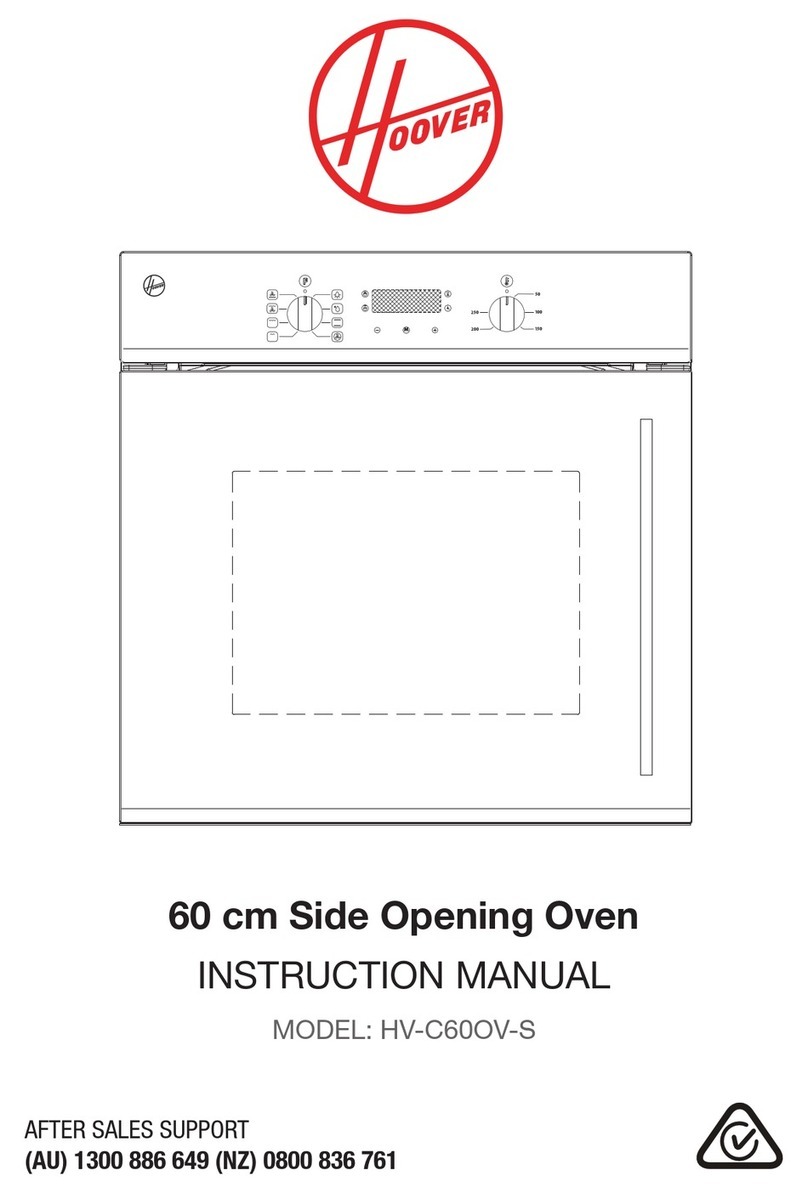
Hoover
Hoover HV-C60OV-S instruction manual
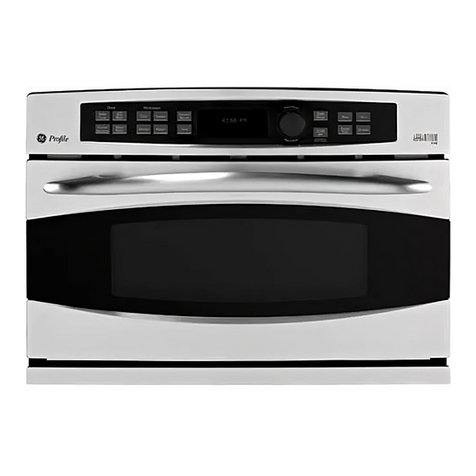
GE
GE Profile Advantium MFL38211607 owner's manual

Middleby Marshall
Middleby Marshall PS314SBI Owner's operating and installation manual

Asko
Asko OT8687B Instructions for use

Belling
Belling Mini Richmond BMR60DOINDB instruction manual
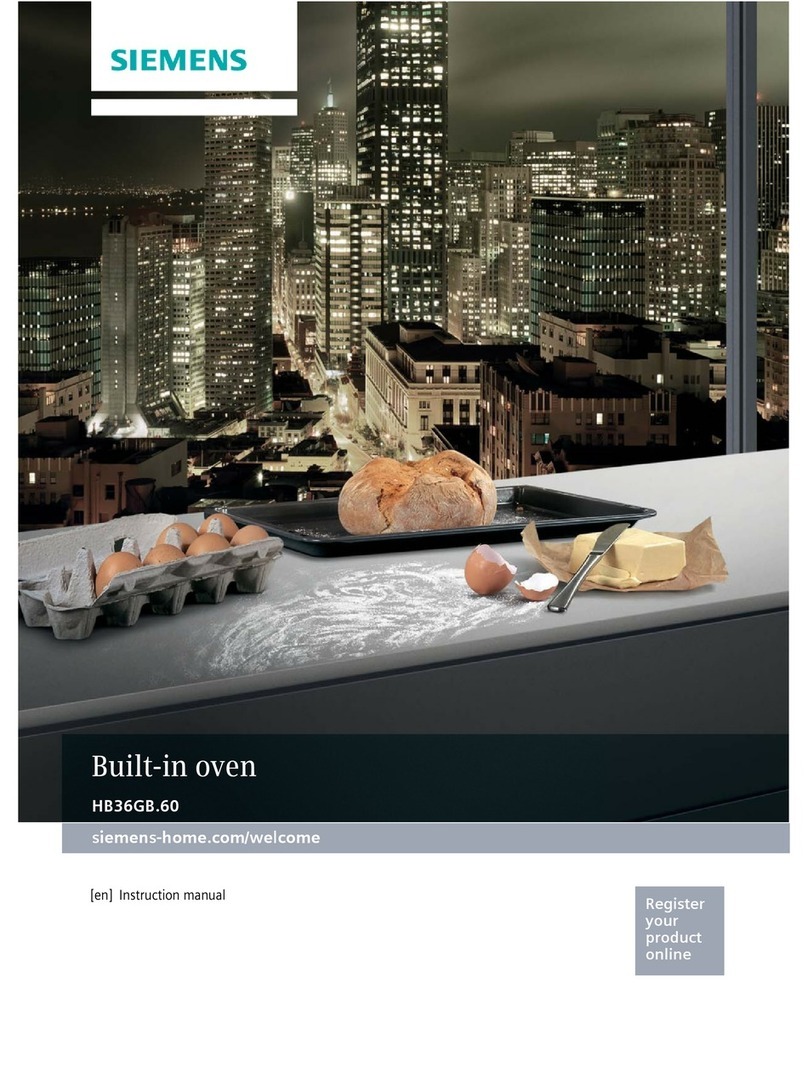
Siemens
Siemens HB36GB.60 instruction manual
